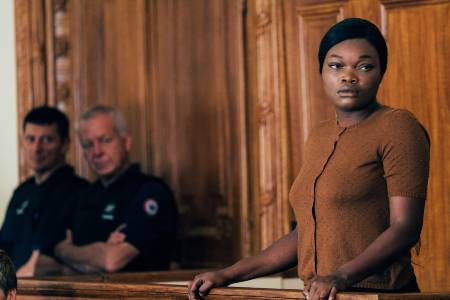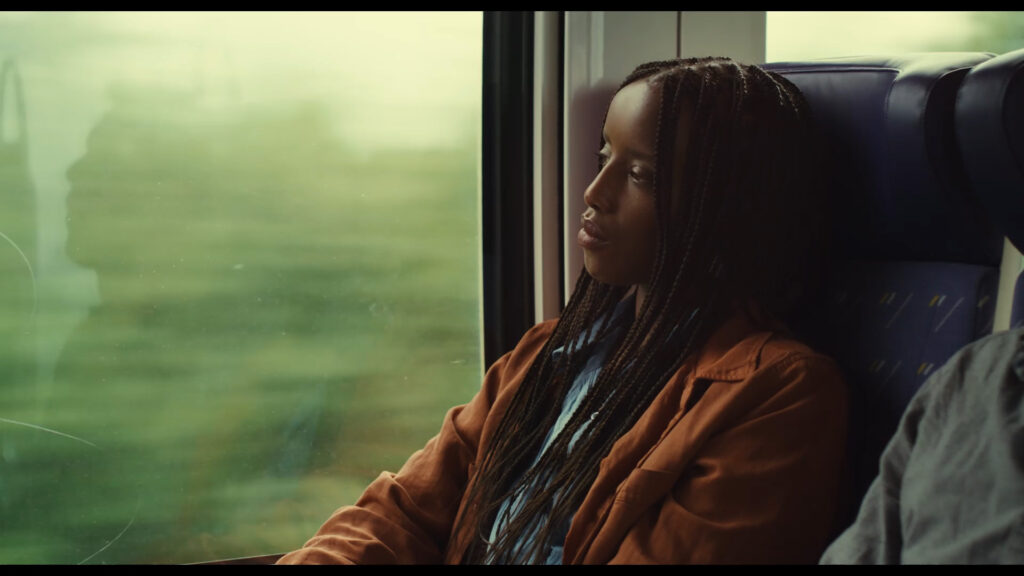Evoking the Greek tragedy Medea, Diop’s inspiration for SAINT OMER was the 2013 news story of a 15 month old girl found drowned on a beach and the French mother of Senegalese origin accused in her death.
With the story covered in almost all news outlets, Diop was drawn to it and the idea for a film was planted. After seeing a photo of the accused mother taken by surveillance camera, Diop decided she would attend the trial in 2016 as an observer and for research to write the film’s script. The trial was a very impactful emotional experience.
In writing the screenplay, Diop used court transcripts which became actual part of the film’s dialogue. From this, she created the characters of Laurence Coly (Guslagie Malanda), as the accused mother and a pregnant young novelist (an extension of Diop), Rama, (Kayije Kagame) attending the trial.
The film starts with Rama waking up from a nightmare of sorts, which comes back later in the film to add more to her complexity. It then briefly introduces us to her husband, and her immediate family at get-together. Diop hints at some sort of troubled family dynamics lurking in the background between Rama, her sisters, and their mother. After dinner, one of the sisters mentions their mother requires help with a medical appointment. Rama quickly responds she cannot assist as she is leaving town for work. They do not know she is on her way to witness the trial of Laurence Coly. Rama does not share much with her family.
Rama arrives at the sea town of Saint Omer, where the trial is to take place. The rest is no procedural film. Diop places us in the courtroom and turns us into observers alongside Rama. As the trial continues, the words of the accused and witness testimonies start to unsettle Rama mentally and emotionally. One evening after the proceedings, Rama breaks down at her hotel. She is filled with mixed emotions, and it is here, we come to know she is pregnant. The trial is having a bigger impact on her than she expected.
The trial is long and full of words, descriptions of what happened, and so forth, almost like a play onstage. The film relies heavily on words. We hear from Laurence about her life in Senegal, her move to Paris for a better education, and her relationship with a much older French man. Laurence is very eloquent and quite honest in providing details of her life and the circumstances that led to the death of her child. In listening to her story, we come to feel Laurence’s convoluted story led to a very low point in her life.
There are also moments when no words are needed. For instance, when we see Rama’s husband quietly watch the family dynamics at play at the larger dinner table. There is also a pivotal moment when Laurence notices Rama in the courtroom. She looks directly at Rama, their eyes meet, and Laurence smiles. It is like an invisible nod that says, “I see you and I think, you see me too.” This sense of ‘being seen’ is key to the film’s essence.
SAINT OMER may be Diop’s first fiction film, however, her work in documentary filmmaking has given her a keen eye and a way with words that create an intensely emotional story. Senegal was a French colony and that history also carries many complexities and nuances that have shaped the way French citizens view people who emigrate from those regions. As a Black French woman, she is aware of what this trial meant for French society at the time. She is also very aware of Laurence and Rama’s respective history given their shared racial and cultural heritage.
Diop deliberately focuses on these two women for a reason. In her director’s notes, she states” in my need to tell the story of these women, there was a desire to inscribe their silence, to repair their invisibility. It’s also one of the political aims of the film… from the void of exile, their exile, the void of our mothers’ lives, the nothingness of their tears, the nothingness of their violence, we tried to compose our own lives. It tries to answer questions with which all women are confronted, while simultaneously speaking specifically about one of the aspects of the history of immigration. How we, Black French women have become mothers through these mothers.”
There are various carefully created layers throughout the film. From the strength of the mythological figure Medea, the complexity of both Laurence and Rama, and the fact that Laurence is neither redeemed nor excused for the violent act she was brought to trial for. We, as observers, are forced to think of the many layers from what we are seeing, hearing, and most importantly, feeling.
In my opinion, the film excels primarily because of the focus on the lead characters. I was deeply impressed by Malanda as Laurene. There is so much grace in her perfomance. Likewise, Kagame as Rama is quiet, observant and evokes a real complex persona. They two radiate onscreen. The whole cast complement the two leads quite well, especially outstanding are Valérie Dréville as the judge and Aurélia Petit as Laurence’s council. The ‘realness’ of the script is personafied in each performance.
Complementing the cast is the cinematography by Claire Mathon, which includes long takes that drive the emotional tone of the film. The camera moves in ways that point us to moments of importance and also bring us closer to Laurence and Rama physically and psychologically. The film’s score by Thibault Deboaisne is very minimal; it does however, include the sound of women chanting at various points in the proceedings. In a recent interview, Diop described wanting the score “to evoke the theatricality and the myth of emotion that I wanted to bring to the film, like a Greek chorus, a group of women together wanting to observe and watch this strange phenomenon that took place.” Then towards the end, she places the Nina Simone song Little Girl Blue, which brought tears to my eyes. It was as if it was allowing me, us, to release the intense emotions brought on by everything we had experienced.
SAINT OMER is a film that does not shy away from harsh realities, even violent acts, none of which we see onscreen. Diop focuses on the women in this film, the mothers, the daughters and their stories. Through words, moments, visuals, and song, it asks you to bear witness and hold space.







